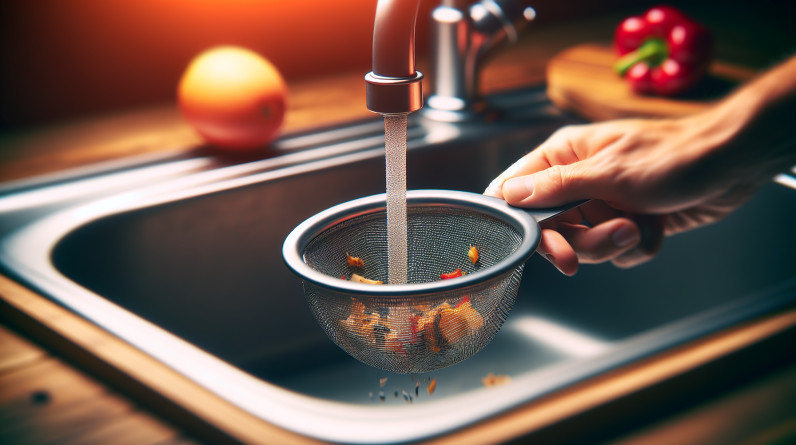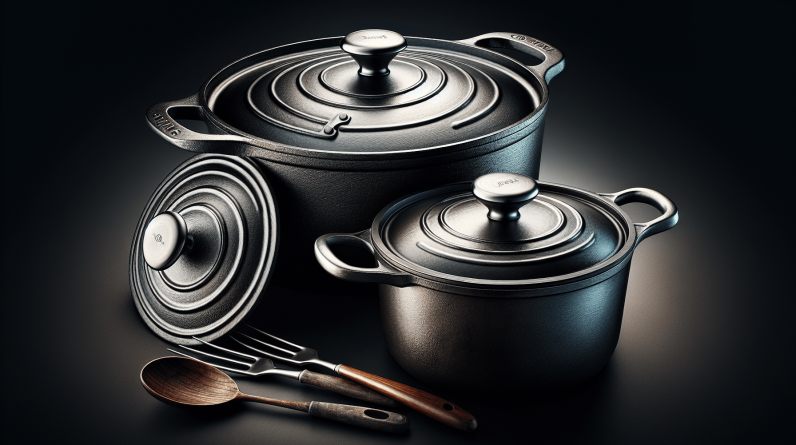We understand the importance of creating an inclusive and welcoming environment for everyone, including those with disabilities. In this article, we will explore practical tips and ideas on how to make your kitchen more accessible. From organizing the space to incorporating assistive devices, we’ll help you transform your kitchen into a functional and accommodating space that enables individuals with disabilities to navigate and enjoy cooking, dining, and socializing. Let’s dive into the world of accessibility and discover ways to make your kitchen a truly inclusive haven.

Layout
Open floor plan
An open floor plan is essential for making a kitchen accessible for people with disabilities. By removing unnecessary barriers and increasing the space between furniture and appliances, individuals using mobility aids such as wheelchairs or walkers can move around freely without obstacles. This allows for easy maneuverability and promotes independence in the kitchen.
Clearance space
In addition to an open floor plan, clearance space is crucial for ensuring accessibility. It is important to have enough room between countertops, islands, and appliances to accommodate individuals with disabilities. The recommended clearance width is at least 36 inches, allowing for easy passage and safe navigation. By maintaining adequate clearance space, individuals can comfortably move throughout the kitchen without feeling cramped or restricted.
Accessible work surfaces
Accessible work surfaces are designed to accommodate individuals with different abilities. This includes countertops that are at a lowered height, allowing individuals who use wheelchairs or other mobility aids to effectively utilize them. These lowered countertops provide a comfortable working height and ensure that individuals can easily reach and prepare food. By incorporating accessible work surfaces into the kitchen design, individuals with disabilities can fully participate in cooking and meal preparation activities.
Cabinetry
Lowered cabinets
Lowered cabinets are a key element in creating an accessible kitchen. By installing cabinets at a lower height, individuals with disabilities can reach items without the need to overextend or strain themselves. This is particularly important for those who use wheelchairs or have limited mobility in their upper body. Lowered cabinets provide easy access to items such as cookware, dishes, and food ingredients, allowing individuals to independently retrieve what they need.
Pull-out shelves
To enhance the functionality of cabinets, pull-out shelves can be installed. These shelves work by sliding outwards, making it easier to reach items stored at the back of the cabinet. This feature eliminates the need to bend down or reach into deep cabinets, reducing the risk of strain or injury. Pull-out shelves are especially beneficial for individuals with limited reach or those who use mobility aids, as they provide greater access and visibility to stored items.
Accessible handles
Choosing accessible handles for cabinetry is an important consideration when making a kitchen more accessible. Opting for handles that are easy to grip, such as D-shaped or loop handles, ensures that individuals with disabilities can easily open and close cabinets. These handles provide a secure grip for those with limited hand strength or dexterity, promoting independence and convenience. Additionally, selecting handles with contrasting colors or textures can help individuals with visual impairments locate and identify cabinets more easily.
Appliances
Adjustable height appliances
Adjustable height appliances play a significant role in making a kitchen more accessible for people with disabilities. By having appliances that can be raised or lowered, individuals can customize the height to suit their specific needs. This is particularly important for tasks such as cooking on a stovetop or using an oven, where individuals may require different heights to safely reach and operate the appliances. Adjustable height appliances provide flexibility and ensure that individuals can comfortably use them without straining or compromising safety.
Easy-to-use controls
Appliances with easy-to-use controls are essential for promoting accessibility in the kitchen. This includes features such as large, well-lit buttons, touch screens, or tactile markings that allow individuals with visual impairments or limited dexterity to operate the appliances independently. By incorporating intuitive and user-friendly controls, individuals with disabilities can effectively and safely use kitchen appliances, ensuring a seamless cooking experience.
Refrigerator with bottom freezer
Choosing a refrigerator with a bottom freezer can significantly enhance accessibility in the kitchen. By placing the freezer section at the bottom, individuals with disabilities can access commonly used food items and drinks at eye level, eliminating the need to bend down or reach overhead. This design feature allows for easier organization and retrieval of items, as well as reduces the risk of injury or strain. A refrigerator with a bottom freezer ensures that individuals can independently and comfortably navigate their kitchen space.
Sinks
Roll-under sinks
Roll-under sinks are an excellent option for increasing accessibility in the kitchen. These sinks have a lower height, allowing individuals using wheelchairs to comfortably roll their chairs underneath the sink. This design feature eliminates the need to lean forward or strain when using the sink, promoting proper posture and reducing the risk of discomfort or injury. Roll-under sinks provide a convenient and inclusive solution for individuals with disabilities to perform kitchen tasks such as washing dishes or preparing food.
Single lever faucets
To make the sink area more accessible, installing single lever faucets is highly beneficial. Single lever faucets are designed with a lever handle that controls both the temperature and water flow. This feature is particularly helpful for individuals with limited hand movement or coordination, as it allows for easy manipulation of the faucet with one hand. By eliminating the need to twist or grip separate handles, single lever faucets promote independence and convenience, making kitchen tasks more manageable for individuals with disabilities.
Insulated pipes
Including insulated pipes in the kitchen sink area is essential for ensuring safety and comfort for individuals with disabilities. Insulating the pipes not only protects against accidental burns from hot water but also prevents potential injury from contact with exposed pipes. By covering the pipes, individuals can confidently use the sink without the risk of burns or injury, enhancing overall accessibility in the kitchen.

Lighting
Proper task lighting
Proper task lighting is crucial for an accessible kitchen. By ensuring adequate lighting in specific work areas, individuals with disabilities can effectively and safely perform various kitchen tasks. Task lighting should be bright, even, and strategically placed to eliminate shadows and provide clear visibility. This is particularly important for individuals with visual impairments or those who require additional lighting to compensate for reduced vision. Proper task lighting ensures that individuals can navigate and work in the kitchen with confidence and ease.
Contrasting colors
Using contrasting colors in the kitchen can significantly enhance accessibility. By incorporating color contrasts between surfaces, appliances, and fixtures, individuals with visual impairments can more easily identify and differentiate between elements in the kitchen. For example, using contrasting colors on countertops and edges can help individuals locate boundaries and navigate the kitchen without confusion. Contrasting colors promote visibility and increase the overall accessibility of the kitchen for people with disabilities.
Motion sensors
Installing motion sensors in the kitchen is a great way to improve accessibility. Motion sensors detect movement and automatically illuminate the area, providing convenient and hands-free lighting. This feature is particularly useful for individuals with limited mobility or dexterity, as it eliminates the need to manually switch on and off lights. With motion sensor lighting, individuals can navigate the kitchen safely, even when their hands are occupied or they have difficulty reaching light switches.
Flooring
Non-slip flooring
To ensure safety and accessibility, non-slip flooring is essential in the kitchen. Choosing flooring materials with slip-resistant properties reduces the risk of falls, especially for individuals with mobility impairments or those using wheelchairs or mobility aids. Non-slip flooring provides traction and stability, making it easier to maneuver and maintain balance while performing various kitchen tasks. By selecting appropriate flooring options, individuals with disabilities can confidently move within the kitchen environment without the fear of slipping or sliding.
Smooth transitions
Smooth transitions between different flooring surfaces are important for maintaining accessibility in the kitchen. Ensuring that there are no abrupt level changes or uneven transitions between floor materials allows for smooth and seamless movement. This is particularly important for individuals using mobility aids, as it reduces the risk of tripping or stumbling. Smooth transitions enhance accessibility by providing a continuous and obstacle-free pathway throughout the kitchen space.
Rounded edges
Incorporating rounded edges in the kitchen flooring contributes to accessibility and safety. Rounded edges on floor materials, such as tiles or laminates, prevent sharp corners or edges that may cause injury or hinder mobility. By eliminating potential tripping hazards, individuals with disabilities can move around the kitchen with ease and confidence. Rounded edges create a more inclusive environment and ensure a smooth and comfortable experience for all users.

Countertops
Lowered countertops
Lowered countertops are a fundamental feature of an accessible kitchen. By installing countertops at a reduced height, individuals using wheelchairs or other mobility aids can comfortably reach and utilize the surface. Lowered countertops provide individuals with disabilities the opportunity to participate in meal preparation tasks and ensure that they can access all areas of the kitchen independently. This inclusionary design approach promotes autonomy and equal participation in the kitchen for individuals with disabilities.
Space for wheelchair access
Providing sufficient space for wheelchair access is critical when designing an accessible kitchen. It is important to ensure that there is enough clearance width between countertops, appliances, and other kitchen elements to accommodate a wheelchair or mobility aid. This allows individuals to easily maneuver within the kitchen and access all areas without restriction. By creating wheelchair-friendly spaces, individuals with disabilities can confidently navigate their kitchen and engage in cooking and meal preparation activities.
Heat-resistant surfaces
Utilizing heat-resistant surfaces is essential for creating a safe and accessible kitchen. By choosing materials that can withstand high temperatures, such as granite or quartz, individuals with disabilities can place hot pots, pans, or dishes on the countertop without worrying about damage or safety hazards. Heat-resistant surfaces are designed to handle direct heat exposure and prevent burns or damages, ultimately ensuring that the kitchen is a secure and comfortable environment for all individuals.
Storage
Accessible pantry
An accessible pantry is a key component of an inclusive kitchen design. By incorporating features such as pull-out shelves, adjustable height racks, or turntables, individuals with disabilities can easily access items stored in the pantry. These accessibility-focused storage solutions eliminate the need to reach or strain when retrieving items, ensuring that individuals can independently navigate and utilize the pantry space. An accessible pantry promotes organization, convenience, and a sense of empowerment for individuals with disabilities.
Clear visibility
Clear visibility is essential for creating an accessible kitchen storage system. By utilizing open shelving, transparent containers, or labeling systems, individuals with disabilities can easily identify and locate items stored in the kitchen. Clear visibility reduces the time and effort required to find specific items, promoting efficiency and independence. Additionally, incorporating proper lighting in storage areas enhances visibility and ensures that individuals with visual impairments can navigate and access items with ease.
Organizational tools
Including organizational tools in the kitchen storage system helps individuals with disabilities maintain order and accessibility. This may involve using dividers, adjustable racks, or pull-out drawers to enhance organization and maximize space utilization. Organizational tools allow individuals to categorize and store items in a manner that works best for their needs. By implementing these tools, individuals can easily locate and retrieve specific items, reducing frustration and promoting self-reliance in the kitchen.
Safety features
Handrails and grab bars
Handrails and grab bars are essential safety features in an accessible kitchen. Installing these supports along walls, near appliances, or near areas prone to slips or falls helps individuals with disabilities maintain balance and stability. Handrails and grab bars provide a secure grip for individuals, preventing accidents and promoting safe and independent movement around the kitchen. These safety features contribute to the overall accessibility of the kitchen environment and allow individuals to navigate with confidence.
Smoke and carbon monoxide detectors
Smoke and carbon monoxide detectors are important safety features that should be included in every kitchen. These detectors alert individuals to potential fire or gas hazards, ensuring early detection and prompt evacuation if necessary. For individuals with disabilities, having accessible smoke and carbon monoxide detectors is crucial. These detectors should have bright, visible indicators and audible alarms that can be easily seen and heard by individuals with visual or hearing impairments. By incorporating these safety devices, individuals can feel secure and protected in their kitchen space.
Fire extinguisher
Having a fire extinguisher readily accessible in the kitchen is vital for ensuring safety. Individuals with disabilities should be able to easily reach and operate the fire extinguisher in case of an emergency. It is recommended to place the fire extinguisher in a visible and easily accessible location, such as under the sink or near the kitchen entrance. Additionally, providing instructions on how to properly use the fire extinguisher ensures that individuals can respond effectively and confidently in the event of a fire. A fire extinguisher is an essential safety feature that promotes preparedness and protects individuals in the kitchen.
Technology
Smart home devices
Incorporating smart home devices into the kitchen can greatly enhance accessibility for individuals with disabilities. Smart devices, such as voice-controlled assistants or automated lighting systems, allow individuals to control various aspects of the kitchen environment without physical effort. By using voice commands, individuals can adjust lighting, control appliances, or access information hands-free. Smart home devices provide convenience, independence, and accessibility for individuals with disabilities, making the kitchen a more inclusive and user-friendly space.
Voice-controlled appliances
Voice-controlled appliances offer a convenient and accessible solution for individuals with disabilities. By using voice commands to operate kitchen appliances, individuals can eliminate the need for manual dexterity or physical exertion. Voice-controlled appliances enable individuals to adjust cooking settings, set timers, or control temperature without relying on traditional buttons or knobs. This accessibility feature enhances independence and promotes an inclusive kitchen environment for individuals with disabilities.
Touchless faucets
Touchless faucets are a technological advancement that greatly improves accessibility in the kitchen. By incorporating motion sensors, these faucets automatically dispense water without the need for physical contact. For individuals with limited hand mobility or dexterity, touchless faucets eliminate the difficulty of gripping or turning traditional faucet handles. This accessibility feature ensures that individuals can easily access water for various kitchen tasks, such as washing hands or filling pots, without relying on manual controls. Touchless faucets promote hygiene, safety, and convenience in the accessible kitchen.









